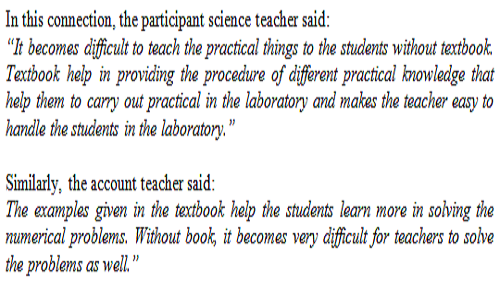
Dynamism of Availability and use of Textbooks: A Hermeneutic Phenomenological Study of School Education in Nepal
Abstract
The main aim of this research paper is to explore the dynamism of availability and use of textbooks in school education of Nepal and giving recognition to pedagogical attributes and quality assurance competencies. Textbooks are reliable and trusted supporting materials that provide deeper understanding of critical concepts on the subject matter. The hermeneutic discussion with five secondary teachers and twenty students from community school of Nepal reports the necessity and glory of textbooks in the daily practices in the classrooms which ultimately equipped for knowledge economy and enhancing skill development for the sustainable growth of the nation. The availability of textbooks provides a mental framework for teachers and students on what and how to teach students and what to learn in the classroom. The research was conducted with the purposive sample with 25 participants of community school from urban and rural area of Nepal. The findings of the research made clear that the availability and use of textbooks are not same and the government of Nepal must allocate sufficient budget to provide textbooks to the school going students so that availability and use of textbooks will be creatively enhanced and also develop the culture of using textbooks and sharing with their friends in the classrooms shaping their future and academic success.
Keywords
Full Text:
PDFReferences
Bashir, I. & Mattoo, N. H. (2012). A Study on study habits and academic performance among adolescents (14-19) years. International Journal of Social Science Tomorrow. 1(5), 1-5.
Bouck, E. C., Weng, P., & Satsangi, R. (2016). Digital versus traditional: Secondary students with visual impairments' perceptions of a digital algebra textbook. Journal of Visual Impairment & Blindness, 110(1), 41-52
Clinton, V. (2018). Savings without sacrifices: A case study of open-source textbook adoption. Open Learning: The Journal of Open, Distance, and e-learning. https://www.researchgate.net/publication/324088320_Savings_without_sacrifice_A_case_report_on_open-source_textbook_adoption
Creswell, J. (2009). Research design (3rd ed.).Thousand Oaks: Sage publication.
Daft, R. L. (2008). The leadership experience (4th ed.). Mason, OH: SouthWestern, Cengage Learning.
Embong, A. M., Noor, A. M., Rafek, M., Othman, H., & Khalid, P. Z.(2014). What do teachers and pupils say about using e-books in the classrooms? International Journal of School Science and Humanity, 4(6).
Fraenkel, J. R., & Wallen, N. E. (1996). How to design and evaluate research in education. (3rd ed.). Thousand Oaks, CA: McGraw-Hill, Inc.
Friensen, N. (2012). Hermeneutic phenomenology in education. Boston: Sense Publishers.
Harmer, J.(2007). The practice of English language teaching. Edinburg: Pearson Education Ltd.
Harwood, N. (2017). What can we learn from mainstream education textbook research? RELC J. 48, 264–277. doi:10.1177/00336882
Hilton, J. (2016) Open educational resources and college textbook choices: A review of research on efficacy and perceptions. Educational Technology Research and Development 64: 573–590
Hilton, J. (2019) .Open educational resources, student efficacy, and user perceptions: a synthesis of research published between 2015 and 2018. Education Tech Research Dev 68, 853–876 (2020). https://doi.org/10.1007/s11423-019-09700-4
Holmberg, J. (2016). Applying a conceptual design framework to study teachers’ use of educational technology. Education and Information Technologies, 22, 2333–2349. doi.org/10.1007 /s10639-016-9536-3.
Griggs, R. A., & Jackson, S. L. (2017) Studying open versus traditional textbook effects on students' course performance: Confounds abound. Teaching of Psychology, 44, 306–312.
Jung, E., Bauer, C., & Heaps, A. (2017). Higher education faculty perceptions of open textbook adoption. The International Review of Research in Open and Distributed Learning, 18(4), 124–141.
Joshi, R. (2018, January 31). Textbooks for all: Students must get them on time. The Himalayan Times. https://thehimalayantimes.com/opinion/textbooks-students-must-get-time/
Knight, B. A. (2015). Teachers’ use of textbooks in the digital age, Cogent Education, 2(1). https://doi.org/10.1080/2331186X.2015.1015812
Knight, B. A., & Horsley, M. (2013). The ecology of change and continuity in the use of textbooks in higher education.
http://www.textjournal.com.au/ speciss/issue23/content.htm
Lokar, M. (2015). The future of e-textbooks. International Journal for Technology in Mathematics Education, 22(3), 101-106. doi:10.1564/tme_v22.3.02
Lussier, R. N., & Achua, C. F. (2007). Leadership: Theory application, skill development (3rd ed.). Mason, OH: Thomson South-Western.
Millar, M., & Schrier, T. (2015). Digital or printed textbooks: Which do students prefer and why? Journal of Teaching in Travel & Tourism, 15(2), 166-185. doi:10.1080/15313220.2015.1026474
MoE. (2016). School sector development plan. Kathmandu: Ministry of Education, Government of Nepal, Kathmandu Nepal.
Mohammad, R. F., & Kumari, R. (2007). Effective use of textbooks: A neglected Aspect of Education in Pakistan. Journal of Education for International Development, 3(1), 1-12.
Moustakas, C. E. (1994). Phenomenological research methods. Thousand Oaks, CA: Sage.
Mullis I. V. S., Martin M. O., Kennedy A. M., Foy P. (2007). PIRLS 2006 International Report. Chestnut Hill, PA.
NASA. (2013). Report on national assessment of student achievement (NASA), Ministry of Education, Kathmandu Nepal.
NCF. (2007). National curriculum framework for school education in Nepal, Ministry of Education, Kathmandu, Nepal.
Nicol C. C., & Crespo S. M. (2006). Learning to teach with mathematics textbooks: how preserve teachers interpret and use curriculum materials. Educ. Stud. Math, 62 331–355. doi:10.1007/s10649-006-5423-y
Parajuli, D. R., & Das,T.(2013). Performance of community schools in Nepal: A macro level analysis. International Journal of Scientific and Technology Research, 2(7), 148-154.
Patton, M. Q. (2002). Qualitative research & evaluation methods (3rd ed.). Thousand Oaks, CA: Sage.
Sammons, P. (2006). School effectiveness and equity: making connections. UK: The University of Nottingham.
Tallvid, M. (2016). Understanding teachers’ reluctance to the pedagogical use of ICT in the 1:1 classroom. Education and Information Technologies, 21(3), 503–519.
DOI: http://dx.doi.org/10.31258/jes.4.4.p.917-929
Refbacks
- There are currently no refbacks.
Copyright (c) 2020 Rupendra Joshi, Megh Raj Dangal

This work is licensed under a Creative Commons Attribution 4.0 International License.
Publisher: FKIP Universitas Riau













